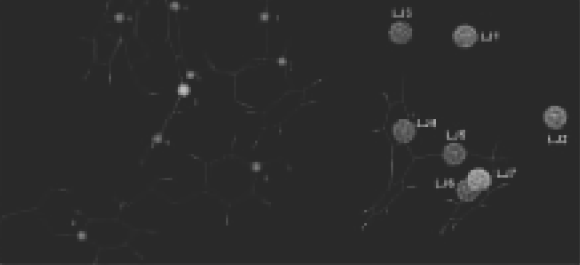118.
Barbosa E. G., Pasqualoto K. F. M., Ferreira M. M. C., "EXPLORING PROTEIN FLEXIBILITY IN 4D-QSAR:
APPLICATION TO A SET OF
TRYPANOTHIONE REDUCTASE INHIBITORS". Rhodes, Greece,
19-24/09/2010: 18th
European Symposium on Quantitative Structure-Activity Relationships:
Discovery Informatics & Drug Design (18th Euro QSAR 2010), Programme & Abstracts Book
(2010) 319-320. Poster II-82.

POSTER
PRESENTATION II-82
EXPLORING PROTEIN FLEXIBILITY IN
4D-QSAR: APPLICATION TO A
SET OF TRYPANOTHIONE REDUCTASE INHIBITORS
Euzébio G.
Barbosa1, Kerly F. M. Pasqualoto2, Márcia M. C. Ferreira1
1Universidade Estadual de Campinas, Campinas-SP, Brazil
2Universidade de São Paulo, USP, Brazil
<>
In 3D-QSAR analysis, the interactions
between ligands and chemical probes are mapped onto a surface or grid
surrounding a set of compounds, which are superimposed in 3D space.
This surface or grid represents a hypothetical binding site of some
biological target. The quality of the QSAR model depends critically on
the correct superimposition of the ligands. However, the absence of
structural information from the target makes the correct ligands’
superimposition almost impossible. The accommodation of ligands in a
binding
site employing methodologies such as automated docking is one way to
handle such situations. But, the docking approaches does not take into
account the protein flexibility,1<> which can be considered
the major drawback. Nowadays, flexible docking methods and/or molecular
dynamics simulations of complexes having docked conformations2<> have been used to
overcome these issues.
In this study the advantages of
docking method followed by the ligand-receptor molecular dynamics simulations were considered to test such
4D-QSAR approach. The conformational ensemble profile (CEP) of each ligand was aligned based upon
both the common structural features from the investigated set of ligands and the relevant amino acid
residues in the binding site (see Fig. 1a). A preliminary set of 33 phenothiazine derivatives acting as
inhibitors of trypanothione reductase (TR) from Trypanosoma cruzi was selected from Ref. 3. TR enzyme is
considered a potential target for the rational design of new selective anti-T.
cruzi agents due to the trypanothione redox-defense system,
which is a fundamental metabolic
difference between the mammalian host and trypanosomal parasite.
LQTAQSAR4
<>models were
built
employing the ordered predictor selection5<> algorithm for variable
selection and partial least squares method for regression. The
y–randomization and leave–N–out cross-validation procedures were
carried out in addition to the external validation. PLS models provided
the following statistics: Q2<> = 0.84, R2<> = 0.91 for 8 variables
selected and 3 latent variables. The selected descriptors presented in
Fig. 1b provided information regarding both intrinsic ligand structural
information as well as key interaction sites within TR binding pocket.
The results are promising and reinforce the importance of induced fit
for building grid based QSAR models.

Figure 1. (a) Atoms
selected to align the CEP of each ligand of the investigated set. (b)
Visualization of the 3D interaction descriptors of the best QSAR model.
319
Rhodes,
September 19-24, 2010
References:
1. Teague S.J., Nat. Rev. Drug.
Discov., 2003; 2(7):527-541. 2.
Hernán A., Andrey A.B., Jill E.G., Med. Res. Rev., 2006;
26(5):531-568. 3. Khan M.O.F.,
Austin S.E., Chan C., Yin H., Marks D., Vaghjiani S.N., Kendrick H.,
Yardley V., Croft S.L., Douglas K.T. J. Med. Chem., 2000;
43(16):3148-3156. 4. Martins
J.P.A., Barbosa E.G., Pasqualoto K.F.M., Ferreira M.M.C., J. Chem. Inf.
Model., 2009; 49 (6):1428-1436. 5.
Reinaldo F.T., João Paulo A.M., Márcia M.C.F., J. Chemom.
2009; 23(1):32-48.
320
18th
European Symposium on Quantitative Structure-Activity Relationships

